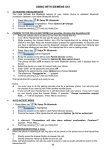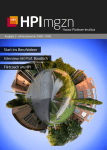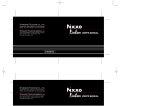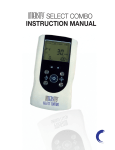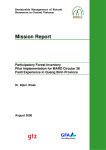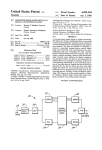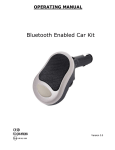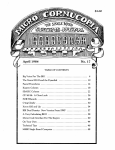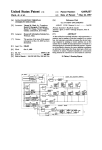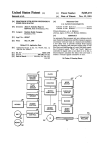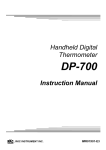Download llllllllllllllllllllllIlllllllllllllllllllIllllllllllllllllllllllllllllIlll
Transcript
l l l l l l l l l l l Il l l l l l l l l lIl l l l l l l l l l l l l l Il l USOO5331554A United States Patent [19] [11] [45] Graham [54] METHOD AND APPARATUS FOR Calif; Ricoh Company Ltd., Tokyo, Japan [21] App]. No.: 988,729 ............................................ .. G06F 15/38 US. Cl. ................................ .. 364/419.07 364/4l9.07, 419.19 mation responsive to the query is located. The present invention includes a computer that stores a data struc ture representing the natural language text of a manual, the structure being a tree structure having nodes, wherein each node represents information from associ ated locations of the text. The nodes at higher levels of Nodes at succeedingly lower levels of the tree represent succeedingly more speci?c categorical subsets of the general categories of information represented at the higher levels by ancestors of the lower level nodes. The query is formatted into a query data structure that is similar in format to the node structure representing the References Cited U.S. PATENT DOCUMENTS 5,056,021 lO/l99l 5,111,398 5/1992 Jul. 19, 1994 the tree represent general categories of information. Dec. 10, 1992 Field of Search .................... .. 364/4l9.08, 419.13, [56] Date of Patent: query regarding information in the text of the manual and the invention displays the locations in which infor [75] Inventor: James M. Graham, San Jose, Calif. [73] Assignees: Ricoh Corporation, Menlo Park, [52] [58] 5,331,554 pattern recognition whereby a user of a manual enters a SEMANTIC PATTERN MATCHING FOR TEXT RETRIEVAL [22] Filed: [511 Int. Cl.5 Patent Number: text. The query data structure is compared to each node in the tree. If the degree of similarity between the query Ausborn ....................... .. 364/4l9.08 Nunberg et a1. ............. .. 364/419.08 and the node exceeds a predetermined threshold value after taking into account the degree of similarity be Primary Examiner-Roy N. Envall, Jr. Assistant Examiner—Xuong M. Chung Attorney, Agent, or Firm—Blakely, Sokoloff, Taylor & tween the ancestors of the node and the query, then the locations associated with the node are displayed on a video monitor as locations containing information re Zafman sponsive to the query. [57] ABSTRACT A method and apparatus utilizing automated semantic TEXT READOUT 57 1. I§ENI5LA§EMENT k A JUSTMENT 26 Claims, 4 Drawing Sheets QUERY INPUT: PLEASE snow ME THE 55 F/ sECTION ON REPLACING \ THE EXPOSURE LAMP. —————-- ——————— 56 2 RELEVANT PAGES PAGE: 5 CONFIDENCE: 100% PAGE: 8 CONFIDENCE: 95% Page 5 /_ / US. Patent July 19, 1994 Sheet 1 of 4 5,331,554 FU SING / 29. Fusing Unit Removal Topics \ ' WARNING: The usin unit is hea and be c‘grefz? when handlvgzg themuzgt.be hot; -Removal 1. Remove the fusing unit knob (1 reverse threaded screw) [A] and the fusing unit cover [B] (3 screws). 2. Open the top unit and slide the fusing unit all the way out. 3. Remove the oil bottle and the oil bottle plate [C] (2 screws). 4. Grasp the fusing unit handles (front and rear) [D], and slide/lift out the fusing unit (2 screws) toward the front. -Instal1ation 5. Fully extend the accuride rails [E]. 6. Align the locatin tabs [F] on the rear of the fusing unit with the oca?ng pins G] on the accuride rails. WARNING: If the following ste is not done, the fusing unit can come away from t e copier accidentally, possibly causing an injury to the operator. 7. Secure the fusing unit to the accuride rails (2 screws). CAUTION: When installing the fusing unit cover, make sure the tab [11] on the inside of the cover lifts up the oil sump stopper [1]. If not, the sump will ?ll and over?ow. p. 3-43 Fig. 1 FUSING ‘29. Fusing Unit Removal -Removal- -Installation Fig. 2 Descriptive Text US. Patent July 19, 1994 Sheet 2 0f 4 5,331,554 ENTER QUERY 1 FORMAT QUERY PARENT : YES MATCH AVG MERGE VECTOR NO Z THRESHOLD? SEARCH NO SAME LEVEL? REWARD NODE 6 YES DISPLAY END OF TREE? MERGE AND SET 2_1 1g CONTRIBUTE FLAG T OR NIL 7 FLAG : T? SCORE : AVG NO (MERGE VECTOR) FLAG : T? 12 SEMI-MERGE MATCH VECTOR WITH PARENT 9 SCORE Z SEMI-MERGE THRESHOLD? VECTOR ¢ NIL? H. STORE FOR DISPLAY YES 1_7 SCORE : AVG(SMV) MATCH AVG 11 ?. SCORE? YES Fig. 3 I SCORE = MATCH AVG 1_6 US. Patent July 19, 1994 Sheet 3 of 4 5,331,554 QUERY = PLEASE SHOW ME THE SECTION ON REPLACING THE EXPOSURE LAMP. SIMPLIFIED SEMANTIC I REPRESENTATION: ((REPLACING) (EXPOSURE LAMP)) Fig. 4a PARENT (0.0 0.0) MATCH (1.0 0. ) MERGE (1.0 0 ) } 1. REPLACEMENT AND ADJUSTMENT A. EXPOSURE (1.0 0.0) LAMP (0.0 1.0) . B. FUSING (1.0 0.0) UNIT (0.0 0.0) C. DRIVE (1.0 0.0) WIRES (0.0 0.0) (1.0 0.0) (1.0 0.0) (1.0 1.0) (1.0 (0.0 (1.0 SEMI-MERGE (1 0 1.0) 0.9) 1.0) 0.9) (i) EXPOSURE BULB (ii) LIGHT (iii) BULB INTENSITY CHECK Fig. 4b F QILERY W EXPOSURE REPLACING ELM? TEXT REPLACEMENT 1.0 3'3 NODE ADJUSTMENT 0.0 ' MATCH VECTOR (1.0 Fig. 4c 0'0) US. Patent July 19, 1994 Sheet 4 of 4 5,331,554 53 ,J DISPLAY s1 r“ INPUT DEVICE 52 H CPU 54 I’ MEMORY Flg. 5a TEXT READOUT 57 1. REPLACEMENT AND ADJUSTMENT QUERY INPUT: PLEASE SHOW ME THE SECTION ON REPLACING /- / THE EXPOSURE LAMP. 2 RELEVANT PAGES PAGE: 5 CONFIDENCE: 100% PAGE:8 CONFIDENCE: 95% Page 5 Fig. 5b / 1 5,331,554 METHOD AND APPARATUS FOR SEMANTIC PATTERN MATCHING FOR TEXT RETRIEVAL 2 the tree is referred to as a “parent” node, while a node at a level immediately below the parent node and repre senting a categorical subset of the information repre sented by the parent node is referred to as a “child” BACKGROUND AND SUMMARY OF THE 5 node of that parent. The parent node and other nodes at INVENTION the higher levels of the tree representing more general categories of information than a particular child node The present invention is a method and apparatus utilizing automated semantic pattern recognition are referred to as the “ancestors” of that child node. whereby a user of an instruction or repair manual enters a query regarding information in the text of the manual propagation from the ancestors of a node to determine and the invention displays the locations in the text of information responsive to the query. Although the in vention is described in terms of its implementation as an aid to a user of a manual, many of the most important features of the invention have general application and are not intended to be limited to text in a manual format. The present invention takes advantage of contextual with a given degree of certainty whether the node con tains information responsive to a query. The query is entered by a user or otherwise input into the system in the hope that the natural language text contains the answer to the query. The query is formatted into a query data structure. The query data structure is com pared to a node to produce a comparison value repre Repair persons or users of a piece of equipment often turn to a manual for instructions regarding operation, sentative of the degree of similarity between the query maintenance of repair. The repair person or user typi and the information represented by the node. The com 20 cally must probe the table of contents and the index for parison value is enhanced by an amount representative relevant words that might point to relevant pages in the of the degree of similarity between the query and the text. Although effective, this method is time consuming. Search time frequently is an important constraint, such information represented by ancestors of the node to produce an enhanced comparison value. If the en as when a customer service representative needs to hanced comparison value exceeds a predetermined respond quickly to questions from customers over the 25 lower bound and the node contributes information re telephone. The present invention uses semantic pattern recogni tion to rapidly locate relevant information in the text of a user manual. Semantic pattern recognition has long been thought of as a possible solution for improving text and information retrieval. Unfortunately, most natural language understanding systems have lacked the lexical and semantic depth necessary for handling the broad range of semantic situations typically encountered as part of daily human activities. However, there are some areas where a language-oriented method of organiza tion and comparison is quite useful. One such domain encompasses information that can be organized topi cally into subject categories. A prime example of topi sponsive to the query, then the location identi?ers asso ciated with the node are stored in memory. The process of comparing the query data structure to a node, en hancing the comparison value and storing the location identi?ers is repeated at each node in the tree structure. After these steps have been performed for the entire tree structure, the stored location identifiers are dis played on the video monitor. Note that the present invention tests whether the node contributes information responsive to the query in addition to determining whether the enhanced compari son value exceeds a predetermined lower bound. Be cause the enhanced comparison value represents the cal organization is the typical user or repair manual, 40 inclusion of information from ancestor nodes, the en hanced comparison value may exceed the lower bound which is divided into sections by topic and uses terse based solely on the degree of similarity between the explanations comprised of highly descriptive words and query and the information represented by the ancestors phrases. of the node, even if there is no match at all between the The present invention locates information in the natu ral language text of a manual using a computer that 45 current node and the query. Accordingly, it is necessary includes a video monitor and a memory device for stor to test whether the current node contains at least some ing a data structure representing the natural language information responsive to the query. text. The data structure has the form of a tree structure In one embodiment, the query is formatted into a query data structure having query constituents that are having nodes arranged at different levels of the tree structure, wherein each node represents information 50 similar in format to the node constituents of the text data structure. That is, each query constituent repre from associated locations in the text, each location hav sents a word or phrase contained in the query. The ing a corresponding location identi?er, such as a page query data structure is compared to a node in the tree to or section number. Each node contains node constitu produce a match vector having a number of match ents representing words or phrases from the text, and each node may be represented by a vector comprising 55 elements, the match vector being representative of the degree of similarity between the query data structure node constituents as elements. The parsing of text into and the node. Each match element corresponds in posi its contextually related constituents is well known in the 2111. tion to one of the query constituents and to one of the Typically, the nodes at higher levels of the tree rep're elements of a parent vector, the parent vector having sent general categories of information. Nodes at suc 60 been initialized to zero. ceedingly lower levels in the tree usually represent succeedingly more speci?c categorical subsets of the general categories of information represented at the higher levels. For example, nodes at one level may The resulting match vector is merged with the parent vector by comparing each parent vector element to each corresponding match element to produce a merge vector having a number of merge elements, each merge represent chapter headings from a manual, while nodes 65 element corresponding in position to a parent element, at the next level may represent sections within a chap and by setting each merge element to be equal to the ter, and nodes at the subsequent level may represent greater of the corresponding parent element and the subsections thereof. Accordingly, a node at one level in corresponding match element. 3 5,331,554 4 A contribution ?ag is set to true if any of the match elements is greater than zero and, at the same time, greater than or equal to the parent element correspond } ing to that match element. If the contribution ?ag has been set to true, then: (1) the merge elements are aver aged to produce a merge vector average; and (2) if the merge vector average equals or exceeds a predeter or score representing how con?dent the system is that the information on the retrieved page is responsive to the query. Although the invention is described in terms mined threshold value, then the location identi?ers associated with the node are stored for display. Note that the terms “enhanced comparison value” and Implementation of the invention will be explained below with reference to the ?gures and the program code included in the Appendix. The pattern matching of the invention may be undertaken using Common LISP running on, for example, a DECstation 5000 workstation. “lower bound” were used above when referring to the invention in its broadest sense. In this particular em bodiment, the merge vector average serves as the en of its implementation as an aid to a user of a manual, many of the most important features of the invention have general application and are not intended to be limited to text in a manual format. FIGS. 1 and 2 demonstrate how text from a manual hanced companion value and the threshold value as the lower bound. 15 may be formatted into a teen structure. FIG. 1 repre sents a page from a copier manual. Using a public do Whether the contribution ?ag has been set to true or main product such as MChart, information from the not, the invention repeats the process of producing the page may be parsed into a Common LISP data struc match vector, merging the match vector with the par ture, and ?tted into a tree structure by topic, as repre ent vector, determining whether to set the contribution ?ag, and, if the contribution ?ag is set to true, averaging 20 sented in FIG. 2. Referring to the ?gures, although “Fusing” and the merge elements and storing the relevant location “Fusing Unit Removal” typically would be listed as identi?ers, wherein all of these steps are performed at each node after substituting for the parent vector the topics in the table of contents, “Removal” and “Installa merge vector that resulted from performing the merg tion” would not be listed. Thus, the resulting text data ing step on the parent node of the node under examina 25 structure as shown in FIG. 2 contains more information tion. After these steps have been performed at each than the table of contents, yet avoids extraneous infor mation contained in the full text. As a result, a search of node in the data structure, then the stored location identi?ers are displayed on the video monitor. the tree structure is faster and more ef?cient than a full The foregoing summary demonstrates that through text database search, and more accurate and compre the merging process, the invention takes advantage of 30 hensive than a search of the table of contents. FIG. 3 is a flow chart illustrating the operation of a the contextual propagation of comparison properties to a node from its ancestors in the tree structure. Instead of preferred embodiment of the present invention. To begin, a query is entered through an input device, such just comparing the match value to the threshold, the invention compares a new value representative of the as a keyboard, regarding the information that is con degree of similarity not only of the present node to the query, but also of the degree of similarity between the tained in the text and that is correspondingly repre sented in the text tree structure, Step 1. As indicated in Step 2, the query is then parsed into a LISP data struc ancestors of the present node and the query. Thus, a node which might otherwise not pass the threshold ture by a program such as MChart. Referring to the Appendix, from this point on, the would be counted as containing relevant information because it has inherited comparison traits from its ances 40 implementation of FIG. 3 may be represented by the main LISP routine search-parsed-tree, which compares tors. BRIEF DESCRIPTION OF THE DRAWINGS FIG. 1 is a page from a photocopier manual. the query to text branch nodes in the tree structure representing sections of a manual. The comparison within each section is performed by the routine new FIG. 2 is a tree structure representing information search-branch, which is called by search-parsed-tree. In from the page of FIG. 1. ' new search branch, the parsed query data structure is FIG. 3 is a flow chart illustrating the operation of the represented by pattern, and the tree text structure by branch. present invention. Moving to Step 3, after parsing, the query data struc FIG. 4a illustrates a simpli?ed semantic representa 50 ture pattern is compared to a node (represented by tion of a query. FIG. 4b illustrates the process of the present inven parsed-data) of the text structure branch, starting at the highest level in the tree. This comparison results in the tion applied to the formatted text of a manual. FIG. 4c illustrates the formation of the match vector. production of a match vector match-result. The match FIG. 5a is a simpli?ed Step diagram of the apparatus vector contains numerical elements representing the 55 degree of similarity between the node and the query. of the present invention. FIG. 5b is an example of the display screen represent ing operation of the present invention using the query The position of each element of the match vector corre sponds to the position of a query constituent in the and text data structure of FIGS. 40 and 4b. query data structure. DETAILED DESCRIPTION OF THE INVENTION The present invention is a method and apparatus The comparison process is carried out by the function match-content, which in turn calls the routine compare two-language-structures. Within compare-two-lan guage-structures, each query constituent is compared to utilizing automated semantic pattern recognition each node constituent at the current node, resulting in a whereby a user of an instruction manual enters a query matrix of “constituent values,” each such value being regarding information in the text of the manual and the 65 representative of the degree of similarity between a query constituent and a node constituent. The compari invention displays the page numbers in which informa tion responsive to the query is located. The pattern son, uses a knowledge base, a technique known in the prior art, to semantically broaden the search by includ matcher also calculates and displays a con?dence level 5 5,331,554 ing contextually related forms of the query constituent in the comparison. For example, the constituent “hard drive” would also be represented by its synonym “?xed disk.” With respect to the details of the comparison, in gen eral, each element of the match vector is set to equal the 6 sults in a match without the aid of contextual propaga tion from its ancestors, then the user can have greater con?dence that information responsive to the query is found on the page containing the corresponding node. Conversely, the more a match relies on contextual prop highest constituent value obtained as a result of compar agation the less certain the user can be that this more “indirect” match has found the correct page. Accord ing that element’s corresponding query constituent to each of the node constituents. For example, referring to ingly, if the current node alone triggers the threshold, then the value of the match vector average is enhanced FIG. 4a, assume that the user enters the query “Please or “rewarded”. This average, whether enhanced or not, show me the section on replacing the exposure lamp.” is compared later on in the process with other con? dence scores obtained by contextual propagation to determine the most representative con?dence score of the match. The match vector average is denoted by new-match-results in the LISP code and is the product of the function individual-match in which the constant value is added. A simpli?ed semantic representation of this query would take the form: ((replacing) (exposure lamp)). Also assume that the text of a repair manual has been formatted into the simpli?ed tree structure shown in FIG. 4b, wherein the ?rst section is entitled “RE PLACEMENT AND ADJUSTMENT”. After for matting, this string may be simply represented as ((re Starting with Step 7, the invention begins to account placement) (adjustment)). for the contextual relationship between a node and its To generate-the match vector, each query constituent 20 ancestors. Initially, the elements of a parent vector, parent, are set to zero or nil value. After the query is is compared to each node constituent, resulting in a compared to a particular node starting at the highest constituent value for each comparison. Thus, as shown in the matrix of FIG. 40, the comparison of the query level in the tree structure, the function new-merge-tree constituent “replacing” with the node constituent “re vectors then merges the resulting match vector, match placement” generates a constituent value of 1.0 because 25 result, with the parent vector to produce a merge vec those two terms are semantically equivalent. On the tor, merged-vector, as indicated in Step 7. Note that the other hand, a comparison of the query constituent “re position of each element of the merge vector corre placing” to the node constituent “adjustment” results in sponds to the position of an element of the parent vec a constituent value of 0.0 because two terms are com tor. Merger is accomplished by setting each merge pletely dissimilar. As for the query constituent “expo vector element equal to the corresponding parent ele sure lamp”, that term matches neither node constituent. ment or the corresponding element of the match vector, whichever is larger. As a result, the ?rst match vector element, correspond As the search algorithm of the invention proceeds ing to the ?rst query constituent “replacing”, is set to 1.0 because that is the highest constituent value ob down a tree branch and compares the query to child tained as a result of comparing the query constituent 35 nodes, each succeeding parent vector is set to equal the “replacing” to each of the node constituents. The sec merge vector that was calculated at the preceding level. This accounts for the contextual relationship between a ond match vector element, corresponding to the second query constituent “exposure lamp”, is set to 0.0 because node and its ancestors because the parent vector now that constituent produced no matches with the node contains information about the similarities between the constituents. Thus, the resulting match vector would 40 query and all contextually related ancestors of the cur rent node. In this manner, the invention takes advantage take the form (1.0 0.0). ' In the unlikely event that the comparison of two or of information inherited from ancestor nodes that hold more query constituents to the same node constituent more general information than that held by the node leads to the highest constituent values obtained for currently subject to scrutiny. Thus, although the match those query constituents, then only the greatest of those 45 vector average alone may not exceed the threshold, the constituent values is included in the match vector. The average of the elements of the merge vector may do so match vector positions corresponding to the remaining query constituents that result in the highest match to the and indicate a match because the merge vector average will always be greater than or equal to the match vector same node are then ?lled with the next highest constitu average due to parental contribution. ent values obtained as a result of comparing those re 50 The function new-merge-tree-vectors also sets a flag, maining corresponding query constituents to the other contribute, which indicates whether the current node “contributes” to the match of that node with the query. node constituents. This process continues if two or more of the remaining query constituents again result in Because the merge vector average represents the inclu the highest match to the same node constituent. This sion of information from the parent node, the average feature, implemented by the function run-best-path, 55 may exceed the threshold based solely on the match provides for a more accurate determination of the simi values contained in the parent vector even if there is no match at all between the current node and the query. larities between the node and the query. To avoid this problem, the flag of Step 7 is set only if Returning back to new-search-branch, after the match vector match-result has been calculated in Step one or more elements of the match vector match-result 3, the elements of the match vector are then averaged as 60 are greater than zero and, at the same time, determined shown in Step 4. As indicated in Step 5, this match to be greater than or equal to the value of the corre vector average is then compared to a predetermined sponding elements of the parent vector. In this manner, the flag indicates that the node currently being exam threshold. If the average equals or exceeds the thresh ined includes information responsive to the query. old, then this node is deemed to match the query and a constant value is added to the match vector average, as 65 For example, referring back FIG. 4b, the match vec shown in Step 6. This average represents the con?dence tor was calculated to be (1.0 0.0). After merging the level of the match of the node to the query. The addi match vector with the parent vector, which is initial tion of the constant is performed because if a node re ized to (0.0 0.0), the merge vector (1.0 0.0) results. That 7 5,331,554 8 merge vector becomes the parent vector as the search equal to the average of the semi-merge vector, as shown proceeds down to the next level of the tree, where the in Step 11. For example, proceeding to the next level in FIG. 4b, query is compared to the node representing “Exposure Lamp”. Here both the query and the node have the term “Exposure Lamp” in common. The resulting match vector would take the form of (0.0 1.0), which when merged with the parent vector (1.0 0.0) results in the merge vector (1.0 1.0). Moreover, the comparison of the match vector (0.0 1.0) with its parent (1.0 0.0) the query would ?rst be compared to the node repre senting “Exposure Bulb”, using the previously calcu lated merge vector (1.0 1.0) as the parent vector. The match with this node would produce a match vector such as (0.0 0.9) because of the semantic similarities between “Exposing Bulb” and “Exposure Lamp”. When this match vector is merged with the parent vec causes the setting of the contribute ?ag to true indicat tor, the result is the merge vector (1.0 1.0), which cer ing that the current node contributes more to the node tainly exceeds the threshold. However, the comparison than the parent vector because the second component of the match vector with the parent vector does not of the match vector, 1.0, is greater than the second result in the setting of the contribute ?ag because when component of the parent vector 0.0. Taking the average comparing the match elements to the parent elements, of the merge vector results in the merge vector average the ?rst match element is less than the ?rst parent ele (1.0+ 1.0)/2: 1.0. Assuming that the threshold were set ment 1.0, and the second match element 0.9 is less than to 0.8, then the threshold would be exceeded and a the second parent element 1.0. Thus, at this point, the match would be deemed to have occurred. Moving algorithm would overlook the match between the query down to the next level of nodes, the parent vector 20 and this node, meaning that a page containing highly would be set to equal the merge vector (1.0 1.0). relevant information would not be retrieved. The pattern matcher of the invention also accounts However, this drawback is overcome by the use of for the fact that even though the contribute flag may this semi-merge process. At the start of this process, the not have been set previously, the current node may still ?rst element of the match vector would be substituted be able to trigger a match with the query without the 25 for the ?rst element of the parent vector resulting in the aid of full contextual propagation. In Step 8, the con vector (0.0 1.0), the average of which would not exceed tribute flag is tested. If it is not set to true, then this the threshold. Thus the process would move on to sub means that none of the match vector elements equaled or exceeded any of the parent vector elements. How stituting the second element of the match vector for the second element of the parent vector, resulting in the ever, it may be the case that by taking only partial ad 30 semi-merge vector (1.0 0.9), the average of which vantage of contextual propagation from ancestor nodes, would exceed the threshold. Therefore, the semi-merge the current node may trigger a match even though the similarity of the current node to the query is not as great as that represented by the parent vector. This situation is exploited starting at Step 9, wherein the match vector is only partially merged with the par ent vector. The function propagate-context performs a one-by-one substitution of match elements into the par ent vector and compares the average of this “semi merge" vector to the threshold. In detail, the ?rst ele ment of the parent vector is replaced with the ?rst element of the match vector, and then the average of process accounts for the fact that a child node can con tribute signi?cantly to a match, although it may not set the contribute ?ag to true, resulting in the retrieval of highly relevant information. The preceding example highlights the advantages of using the contextual relationship between a node and its ancestors in semantic pattern recognition. Without uti lizing that relationship, the pages associated with the nodes containing the phrases “Exposure Lamp” and this semi-merge vector is compared to the threshold. If “Exposure Bulb” alone would not have been deter mined to have represented information relevant to the query, unless the threshold were lowered substantially. the threshold is equaled or exceeded and the substituted However, lowering the threshold would have degraded match vector element is greater than zero, then execu 45 the system performance and caused page numbers of tion of the propagate-context function stops and the nonresponsive pages to be deemed as matches. semi-merge vector is returned as propagated-results. (Testing whether the substituted element is greater than Referring back to Step 10, if the propagate-context function results in no matches, i.e., a nil semi-merge zero ensures that the node contributes information re vector, then the con?dence level tree-node-score is set sponsive to the query). On the other hand, if the thresh 50 to equal the average of the merge vector elements, as old is not exceeded during that substitution or the sub shown in Step 12, and the contribute ?ag is tested, Step stitute element is of zero value, then propagate-context 13. If the flag is nil then at this point it has been deter replaces the next element of the parent vector with the mined that the current node does not match the query corresponding element of the match vector, resulting in even though the match vector average may exceed the a semi-merge vector containing all the elements of the 55 threshold. Thus, the search moves on to another node. parent vector except for the second element, which If, however, the ?ag is true then the merge vector now constitutes the second match element. The func average is compared with the threshold, Step 14. If the tion propagate-context then compares the average of threshold is exceeded, this means that the current node, that semi-merge vector to the threshold. This process with the help of full contextual propagation, results in a continues until either the ?rst time the threshold is ex 60 match. As mentioned above, by testing the contribute ceeded using a non-zero match vector element or each ?ag, the invention ensures that the match was not just element of the parent vector has been subject to substi due to the contributions of ancestor nodes as repre tution. If the threshold is not exceeded during any of the sented by the parent vector, but was also the result of a substitutions, then the vector propagated-results is as contribution of the current node. signed a value of nil. 65 At this point in the process, it has been determined If propagate-context does in fact result in a non-nil whether the threshold has been exceeded by either the propagated results semi-merge vector, then the con? dence level tree-node-score is, at least temporarily, set current node itself (as represented by the match vector), the current node taking partial advantage of contextual 5,331,554 propagation (as represented by semi-merge vector 10 1. A method for locating information in a natural language text using a computer including a video moni propagated results), or the current node taking full advantage of contextual propagation (as represented by tor and a memory device for storing a data structure the merge vector merged vector). The averages of these representing the natural language text, vectors represent alternative measures of con?dence 5 level scores at a particular node. As shown in Steps l5 and 16, the con?dence level tree-node-score is set equal wherein said data structure has a tree structure hav ing nodes and levels, each node representing infor mation from associated locations in said text, each to the match vector average new-match-results if that of said locations having a corresponding location average exceeds the previously calculated score, which is either the semi-merge vector average or the merge identi?er, the information in a node being a cate gorical subset of information represented by a par vector average depending on whether the contribute flag is true or nil. Otherwise, the score remains un changed. This ensures that the most accurate con? dence level is stored for the match of the current node ent node of that node, each node being one level below its parent node in the tree structure and to the query, along with the page number(s) (or other location identi?ers) of the matched node, Step 17. represent more general categories of information than the information represented by a node being ancestors of that node, the method comprising the steps of: containing node constituents, said parent node and the nodes at higher levels of the tree structure that After the score has been stored for the matched page(s), or, alternatively, if the current node resulted in no match even with the help of contextual propagation, then the match process is continued on sibling nodes on the same level or child nodes at the next level, Step 19, formatting a query regarding information in the text into a query data structure; comparing the query data structure to a node to pro duce a comparison value representative of the de gree of similarity between the query and the infor as long as there are nodes left in the tree that have not been tested, Step 18. If a child node is to be tested, then mation represented by the node; the parent vector for that node is set to the current merge vector in order to continue contextual propaga tion, Step 20. Once the entire tree has been searched, then the page numbers of the pages that resulted in a match are displayed along with their corresponding con?dence levels, Step 21. 30 FIG. 5a is a simpli?ed blocked diagram of the appara tus used to implement the method of the present inven enhancing the comparison value by an amount repre sentative of the degree of similarity between the query and the information represented by ancestors of the node to produce an enhanced comparison value; and storing the location identi?ers associated with the ' node if the enhanced comparison value exceeds a predetermined lower bound and the node contrib tion. The query is inputted through input device 51. All utes information responsive to the query. calculations and the comparison of the query to each 2. The method of claim 1, further comprising the node of the tree structure representing the text is carried 35 steps of: out by a central processing unit 52, and the results dis performing said comparing, enhancing, and storing played on display 53. A memory 54 is used for storing steps at each node in the tree structure; and displaying the stored location identi?ers on the video one embodiment of the layout of the display showing monitor. the query input being displayed in ?eld 55 and the num 40 3. A method for locating information in a natural bers of the pages containing responsive information and language text using a computer including a video moni the accompanying con?dence levels displayed in ?eld tor and a memory device for storing a data structure 56. Field 57 demonstrates that the user has the option of representing said natural language text, the text data structure and other information. FIG. 5b is retrieving the text of the manual, including those pages containing information responsive to the query. 45 In this particular example, FIG. 5b shows the results of entering the query of FIG. 4a where the user manual is represented by the tree structure of FIG. 4b. In Field 56 “page 5" represents the page containing the subsec ing nodes and levels, each said node representing information from associated locations in said text, each said location having a corresponding location identi?er, the information in a node being a cate gorical subset of information represented by a par tion entitled “Exposure Lamp”. Referring back to FIG. 4b, the resulting merge vector for that subsection node is (1.0 1.0). Thus the merge vector average and the accompanying con?dence level score (1.0+1.0)/2= 1.0 ent node of that node, each said node being one level below its parent node in said tree structure and containing node constituents, said method comprising the steps of: or 100 percent. Similarly, page 8 contains a node repre senting the sub-subsection entitled “Exposure Bulb", wherein said data structure has a tree structure hav 55 formatting a query regarding information in said text into a query data structure containing constituents of said query, each said query constituent repre which resulted in a semi-merge vector of (1.0 0.9) and a con?dence level of (l.0+0.9)/2=O.95 or 95 percent. Thus, the invention provides a convenient way for a producing a match vector having a plurality of match user or a repair person to know with relative certainty which pages of a manual contain information relevant elements, said match vector being representative of a degree of similarity between said query data to the task at hand without the need for manually pag ing through the index and the indicated text. structure and one of said nodes, and each said match element corresponding in position to a pre Although the invention has been described in con~ junction with the preferred embodiment, it will be ap preciated that various modi?cations and alterations 65 might be made by those skilled in the art without de parting from the spirit and scope of the invention. What is claimed is: senting a word or a phrase contained in said query; determined query constituent and to a predeter mined parent element of a parent vector; merging said match vector with said parent vector to produce a merge vector having a plurality of merge elements, wherein each said merge element corresponds in position to a predetermined parent 11 5,331,554 after said setting step: if said contribution ?ag is not true: successively replacing one element of the parent vector at a time with the corresponding match element to produce a semi-merge vector, the corresponding parent element; setting a contribution flag to true if any of said match elements is greater than zero and, at the same time, greater than or equal to said parent element corre wherein said semi-merge vector comprises all the elements of the parent vector except for the substituted match element, either until the average of the elements of said semi-merge vector equals or exceeds the predetermined threshold and the corresponding match ele sponding to said match element; if said contribution flag is set to true: averaging said merge elements to produce a merge vector average; storing the location identifiers associated with said node if said merge vector average equals or ex ceeds a predetermined threshold value, whereby said stored location identi?ers represent loca 15 tions in said natural language text containing information responsive to said query; whether said contribution ?ag is true or not: performing, at each node in said data structure, said steps of producing a match vector, merging, setting a contribution flag, and, if said contribu tion ?ag is set to true, averaging and storing, wherein all said steps are performed at each said node after substituting for said parent vector said 25 merge vector that resulted from performing said merging step on said parent node of said node; and displaying on said video monitor said stored loca tion identi?ers. 30 4. The method of claim 3, wherein said storing step further comprises the step of storing associated with said stored location identi?ers, and displaying on said video monitor. said con?dence ment exceeds zero value, or until each element of the parent vector has been subject to re placement; and thereafter setting said semi merge vector equal to a nil value if the average of the elements of said semi-merge vector does not equal or exceed the threshold; if said semi merge vector is not nil: averaging the elements of said semi-merge vec tor to produce a semi-merge vector average; if said enhanced match vector average is greater than said semi-merge vector average, storing for display said enhanced match vector aver age as a con?dence score associated with said stored location identi?ers; and if said enhanced match vector average is not greater than said semi-merge vector average, storing for display said semi-merge vector average as a con?dence score associated with said stored location identi?ers, wherein said performing step further comprises the step of performing the above steps at each node in said merge vector average as a con?dence score said displaying step further comprises the step of 12 6. The method of claim 5, further comprising the steps of: element by setting each said merge element to be equal to the greater of its corresponding parent element and the match element corresponding to 35 said data structure. 7. The method of claim 6, wherein said averaging step to produce the semi-merge vector average comprises the steps of adding together the elements of said semi scores associated with said stored location identi ?ers. 5. The method of claim 3, further comprising the steps of: after producing the match vector: merge vector to produce a semi-merge vector total, and dividing the semi-merge vector total by the number of elements in said semi-merge vector to produce said semi-merge vector average. 8. The method of claim 5, wherein said averaging step to produce the match vector average comprises the averaging said match elements to produce a match vector average; adding a constant value to said match vector aver age to produce an enhanced match vector aver age if said match vector average equals or ex steps of adding together said match elements to produce a total, and dividing the total by the number of match elements in said match vector to produce said match ceeds said predetermined threshold; said storing step further comprising the steps of: vector average. if said merge vector average equals or exceeds said predetermined threshold and said contribution ?ag is set to true: if said enhanced match vector average is greater than said merge vector average, storing for display said enhanced match vector average as a con?dence score associated with said stored 55 location identi?ers; and if ‘said enhanced match vector average is not greater than said merge vector average, stor ing for display said merge vector average as a con?dence score associated with said stored 60 9. The method of claim 3, wherein the step of produc ing the match vector comprises the steps of: comparing each said query constituent with each said node constituent at a particular node to produce a constituent value representative of a degree of similarity between said query constituent and said node constituent; and setting each said match element equal to the highest constituent value obtained as a result of comparing the query constituent corresponding to said match element to each said node constituent. location identi?ers; said performing step further comprising the step of 10. The method of claim 9, further comprising the steps of: after said comparing step: performing the above steps at each node in said data structure; and if the comparison of two or more query constituents to the same node constituent results in the highest said displaying step further comprising the step of 65 constituent values obtained for said two or more displaying on said video monitor said con?dence query constituents: scores associated with said stored location identi selecting the greatest of said highest constituent values and setting the match element in the posi ?ers. 13 5,331,554 greatest constituent value; tor and a memory device for storing a data structure setting the match elements corresponding in posi representing said natural language text, tion to the remaining query constituents that 5 resulted in the highest match to the same node to wherein said data structure has a tree structure hav ing nodes and levels, each said node representing information from associated locations in said text, the next highest constituent value obtained as a result of comparing said remaining query constit each of said locations having a corresponding loca uents to the other node constituents; and repeating said selecting and setting steps immedi 14 17. A system for locating information in a natural language text using a computer including a video moni tion corresponding to the query constituent asso ciated with said greatest constituent value to the ' tion identi?er, the information in a node being a 10 ately above if two or more of the remaining categorical subset of information represented by a parent node of that node, each said node being one level below its parent node in said tree structure query constituents again result in the highest and containing node constituents, match to the same node constituent. 11. The method of claim 3, wherein said averaging step to produce the merge vector comprises the steps of 15 adding together said merge elements to produce a total, and dividing the total by the number of merge elements in said merge vector to produce said merge vector aver age. 12. The method of claim 3, further comprising the 20 step of a user inputting the query. said system comprising: query formatting means for formatting a query regarding information in said text into a query data structure containing constituents of said query, each said query constituent representing a word or a phrase contained in said query; matching means for producing a match vector having a plurality of match elements, said match vector being representative of a degree of simi 13. The method of claim 3, further comprising the step of determining the threshold value according to a user input. 14. The method of claim 3, wherein said location 25 identi?ers are page numbers. 15. The method of claim 3, said displaying step fur ther comprising the step of displaying on said video monitor the text of the locations containing information responsive to said query. 30 larity between said query data structure and one of said nodes, and each said match element cor responding in position to a predetermined query constituent and to a predetermined parent ele ment of a parent vector; merging means for merging said match vector with said parent vector to produce a merge vector 16. A system for locating information in a natural language text using a computer including a video moni having a plurality of merge elements, wherein each said merge element corresponds in position to a predetermined parent element, by setting tor and a memory device for storing a data structure each said merge element to be equal to the representing the natural language text, greater of its corresponding parent element and wherein said data structure has a tree structure hav 35 sponding parent element; ing nodes and levels, each node representing infor mation from associated locations in said text, each of said locations having a corresponding location identi?er, the information in each node being a categorical subset of information represented by a parent node of each node, each node being one level below its parent node in the tree structure and containing node constituents, said parent node and the nodes at higher levels of the tree structure that represent more general categories of information 45 than the information represented by a node being the system comprising: predetermined threshold value; storing means responsive to said threshold testing means for storing the location identi?ers associ structure; comparison means for comparing the query data ated with said node if said merge vector average equals or exceeds said predetermined threshold value, whereby stored location identi?ers repre structure to a node to produce a comparison value representative of the degree of similarity between enhancing means for enhancing the comparison value by an amount representative of the degree of simi larity between the query and the information repre sented by ancestors of the node to produce an en hanced comparison value; elements to produce a merge vector average; said merge vector average equals or exceeds a query formatting means for formatting a query re garding information in the text into a query data the query and the information represented by the contribution detecting means for setting a contribu tion flag to true if any of said match elements is greater than zero and, at the same time, greater than or equal to said parent element correspond ing to said match element; contribution testing means for determining whether said contribution flag is set to true; merge averaging means responsive to said contri bution testing means for averaging said merge threshold testing means for determining whether ancestors of that node, node; the match element corresponding to the corre 55 sent locations in said natural language text con taining information responsive to said query; substitution means for substituting said merge vec tor for said parent vector; and display means for displaying on said video monitor said stored location identi?ers. 18. The system of claim 17, said storing means further comprising means for storing said merge vector average storing means for storing the location identi?ers asso ciated with the node if the enhanced comparison as a con?dence score associated with said stored loca value exceeds a predetermined lower bound and tion identi?ers, and the node contributes information responsive to the 65 said display means further comprising means for dis query; and playing on said video monitor said con?dence display means for displaying the stored location iden scores associated with said stored location identi ti?ers on the video monitor. ?ers. 15 5,331,554 16 19. The system of claim 17, further comprising: match averaging means for averaging said match said comparison means further comprising means for elements to produce a match vector average; reward means for adding a constant value to said match vector average to produce an enhanced match vector average if said match vector average vector average and the semi-merge vector average. outputting the greater of the enhanced matched 21. The system of claim 17, wherein said matching means comprises means for comparing each said query constituent with each said node constituent at a particu lar node to produce a constituent value representative of a degree of similarity between said query constituent equals or exceeds said predetermined threshold; comparison means for outputting the greater of said and said node constituent, and for setting each said match element equal to the highest constituent value enhanced match vector average and said merge vector average; obtained as a result of comparing the query constituent corresponding to said match element to each said node said storing means coupled to‘said comparison means for storing for display the output of said compari constituent. 22. The system of claim 21, further comprising: check means for setting a check ?ag if the compari son means as a confidence score associated with said stored location identi?ers; and said display means further comprising means for dis playing on said video monitor said con?dence scores associated with said stored location identi ?ers. 20. The system of claim 19, further comprising: son of two or more query constituents to the same node constituent results in the highest constituent values obtained for said two or more query constit uents; 20 semi-merge means coupled to said contribution test ing means for successively replacing one element of the parent vector at a time with the correspond ing match element to produce a semi-merge vector if said contribution ?ag is not true, wherein said 25 semi-merge vector comprises all the elements of the parent vector except for the substituted match means coupled to said check means for selecting the greatest of said highest constituent values and set ting the match element in the position correspond ing to the query constituent associated with said greatest constituent value to the greatest constitu ent value if said check ?ag is set; means for setting the match elements corresponding in position to the remaining query constituents that resulted in the highest match to the same node to the next highest constituent value obtained as a element, either until the average of the elements of said semi-merge vector equals or exceeds the pre determined threshold and the corresponding match 30 element exceeds zero value, or until each element result of comparing said remaining query constitu ents to the other node constituents if said check ?ag is set. 23. The system of claim 17, further comprising query of the parent vector has been subject to replace ment, and for thereafter setting said semi-merge input means for enabling a user to input the query. vector to a nil value if the average of the elements 24. The system of claim 17, further comprising a of said semi-merge vector does not equal or exceed threshold input means for determining said threshold the threshold; semi-merge testing means for determining whether said semi-merge vector is nil; semi-merge averaging means responsive to said semi value in response to a user input. 25. The system of claim 17, wherein said location identifiers are page numbers. 26. The system of claim 17, wherein said display merge testing means for averaging the elements of said semi-merge vector to produce a semi-merge vector average if said semi-merge vector is not nil; means further comprises means for displaying on said video monitor the text of the locations containing infor mation responsive to said query. # and 45 50 55 65 i i i Q














